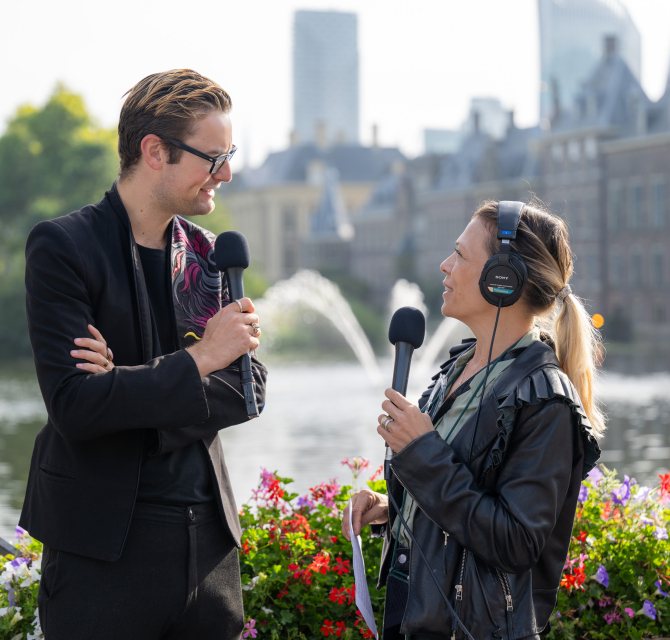
Tamara Bok and Splinter Chabot present a new podcast in search of freedom in The Hague
18 September 2023
The Hague – The Hague is known all over the world as the city of peace and justice. But how does the city do justice to this special status? Today, on the International Day of Democracy, Tamara Bok and Splinter Chabot look for freedom in The Hague in a new podcast.
In the third episode of the series Den Haag Revealed, writer, program maker and proud resident of The Hague Splinter Chabot takes podcast maker Tamara Bok through his home city in search of answers. They investigate how people experience freedom, where free speech is heard and which places in The Hague stand for peace and justice.
International impact
On their journey of discovery, they visit various iconic places in The Hague and soon encounter a group of demonstrators. Tamara gets a tour of the Peace Palace where she is given an explanation about the international impact of the two courts that are housed in the impressive building. She also learns about the life of the Austrian activist Bertha von Suttner who was in The Hague more than a hundred years ago and fought for the 'laying down of arms'.
Blackmail
When he arrives at the Binnenhof, Splinter explains that as a child he could still run through the corridors of the complex. And even though those times are now over, he explains for him The Hague is not only the city of peace and justice, but also the city of freedom. Tamara discovered at Paleis Kneuterdijk that this freedom is sometimes a bit of a nuisance. Splinter tells how, according to some, King Willem II changed from a conservative man to a liberal leader in one night, and the possible blackmail that lay behind it. The young city poet of The Hague knows how to express the fact that freedom is still a nuisance and is not self-evident everywhere in the world. Fifteen-year-old Chelsy Valentina recites her own poem in Theater Pepijn about her feelings about peace, who then becomes a bit silent.
Resistance fighters commemorated
After a short bike ride, Tamara arrives at the Waalsdorpervlakte together with Splinter. There are memorials here that commemorate the resistance fighters who were murdered during the German occupation in the Second World War. On the top of the dune behind the memorials is an impressive bell that can be heard throughout The Hague every year on May 4. These sacrifices for freedom are still commemorated every year, a sound that Splinter has many personal memories of.
Tamara and Splinter continue their journey in the center of The Hague, where Splinter shows the gay monument and explains the symbolism of the artwork. The next stop is outside at Sociëteit Westwood where King Willem-Alexander used to stand on the dance floor as crown prince and could enjoy a bit of freedom there on Friday evening.
Glass cage
From the dance club, Tamara and Splinter continue to the Couperus Museum where Tamara learns about the special life of writer Louis Couperus. Contemporaries saw him as an eccentric appearance with a lifestyle that was not understood or accepted by everyone. In the museum this is shown by depicting him in a glass cage.
The journey of discovery ends on the Malieveld, where all kinds of freedom, of speech, culture and expression, come together in one place. Here Splinter expresses one last wish about how he hopes that peace, justice and freedom will eventually - with a little help from The Hague and the rest of the world - reach 'to the heavens'.
The third episode of the series The Hague Reveals can now be listened to on denhaag.com/podcast and on the podcast channels Spotify, Apple and SoundCloud, just like the other two episodes, 'The Hague, City by the Sea' and 'The Hague, the Hometown of Escher'.